Marmorkrebs aka Marbled Crayfish
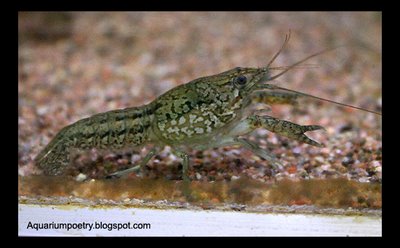 The Marmorkrebs grows up to 10-12 cm and is omnivorous. The water pH is not critical, but keeping alkaline pH with medium hardness is preferred. They tolerate temperatures between 4-30 Celsius, and for that reason it is very important not to release them into nature not native to Procambarus spp (many believed that this crayfish is the Procambarus fallax but lately researches indicate that this is a new specie, which origins are unknown). Its been known that this crayfish needs only wet grass to thrive and breed, but that fact has not been documented yet.
The Marmorkrebs grows up to 10-12 cm and is omnivorous. The water pH is not critical, but keeping alkaline pH with medium hardness is preferred. They tolerate temperatures between 4-30 Celsius, and for that reason it is very important not to release them into nature not native to Procambarus spp (many believed that this crayfish is the Procambarus fallax but lately researches indicate that this is a new specie, which origins are unknown). Its been known that this crayfish needs only wet grass to thrive and breed, but that fact has not been documented yet.Tank size for one Marmorkrebs should be 50 liters. For a pair or more 100 liters and up, depending on the number. Shelters like pots and bog wood should be provided for the moulting crayfish to hide until the new exoskeleton harden up (after one day).
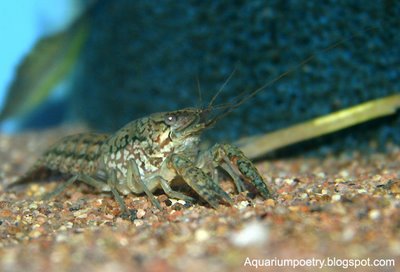 There is an interesting phenomena about this crayfish. No one ever witnessed a male performing fertilisation. Even if just one is kept on its own, the eggs will form and hatch without male fertilisation. Is it possible that Marmorkrebs can reproduce parthenogenetically??
There is an interesting phenomena about this crayfish. No one ever witnessed a male performing fertilisation. Even if just one is kept on its own, the eggs will form and hatch without male fertilisation. Is it possible that Marmorkrebs can reproduce parthenogenetically??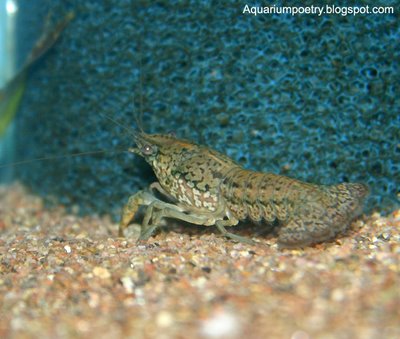 Some sites like this one say that this crayfish spp will not attack fish, at least not the fast moving ones. But it is known that if not enough food provided it will catch an kill slower moving fish like the Fancy Goldfish.
Some sites like this one say that this crayfish spp will not attack fish, at least not the fast moving ones. But it is known that if not enough food provided it will catch an kill slower moving fish like the Fancy Goldfish.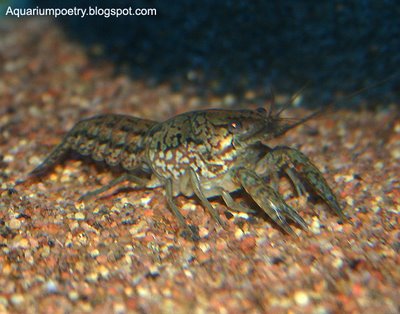 In Sweden, it is illegal breeding, keeping or selling any types of crayfish except Astacus astacus and Pacifastacus leniusculus. The Swedish law (11a and 11b). In the last photo one can see the reddish variation of the Marmorkrebs.
In Sweden, it is illegal breeding, keeping or selling any types of crayfish except Astacus astacus and Pacifastacus leniusculus. The Swedish law (11a and 11b). In the last photo one can see the reddish variation of the Marmorkrebs.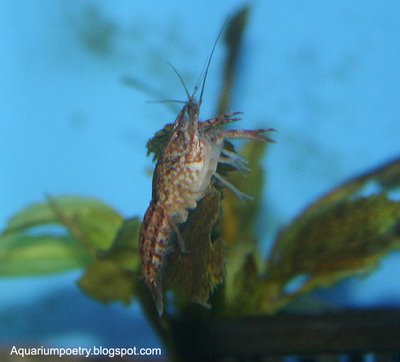 Quote;
Quote;
Recently, we briefly reported on the first case of parthenogenesis in the decapod Crustacea which was found in the Marmorkrebs or marbled crayfish, a cambarid species of unknown geographic origin and species identity. Curiously, this animal is known only from aquarium populations, where it explosively propagates. By means of light and electron microscopic techniques we have now investigated the reproductive components of this crayfish, using more than 100 specimens ranging from hatchling to repeatedly spawned adult. Additionally, we documented its principal life stages. Our results revealed that the external sexual characters and also the gonads of the marbled crayfish are purely female, making this fast-reproducing species a good model for investigating female reproductive features in crayfish. Testicular tissues, ovotestes, or male gonoducts, gonopores, or gonopods were never found, either in small juveniles or large adult specimens, confirming the parthenogenetic nature of this crayfish. Parthenogenesis may have arisen spontaneously or by interspecific hybridization since Wolbachia-like feminizing microorganisms were not found in the ovaries. The external sexual characters of the marbled crayfish are first recognized in Stage 4 juveniles and are structurally complete 2 months after hatching in specimens of 2 cm total length. In the same life stage the ovary is fully differentiated as well, although the oocytes are in previtellogenic and primary vitellogenic stages only. The architecture of the mature ovary and also the synchronous maturation of cohorts of primary vitellogenic oocytes by secondary vitellogenesis are in general agreement with data published on ovaries of bisexual crayfish. New results were obtained with respect to the muscular nature of the ovarian envelope and its extensive proliferation after the first spawning, the distribution of hemal sinuses in the ovarian envelope and in the interstitium around the oogenetic pouches, the high transport activity of the follicle cells, and the colonization of oogenetic pouches by previtellogenic oocytes that originate in the germaria. Investigation of the nuclei of oocytes in the germaria and oogenetic pouches revealed no signs of meiosis, as usually found in females of bisexual decapods, suggesting that parthenogenesis in the marbled crayfish might be an apomictic thelytoky. The detection of new rickettsial and coccidian infections in the ovary and further organs raises fears that the marbled crayfish might endanger native European species by transmission of pathogens once escaped into the wild. J. Morphol. 261:286-311, 2004. © 2004 Wiley-Liss, Inc. from Inter Science
Quote; London, UK (19 Feb 2003)
A mysterious self-cloning female crayfish, popular with German aquarium owners, could pose a threat to native European species if it were released into the wild, scientists said Wednesday. The marbled crayfish, called Marmorkrebs, is probably related to a North American species although scientists at Humboldt Universety in Berlin admit they do not know exactly where it originated. But they are sure that it can reproduce without mating. Parthenogenesis, a form of self-cloning, is found in creatures such as snails and water fleas but is unusual for crayfish. The Marmorkrebs ability to produce 20 or more clones of itself in six moths could be a danger and a competitor to crayfish in the wild, according to Gerhard Scholtz, a comparative zoologist at the university. "It might pose a threat to European native crayfish" said Scholtz. Marmorkrebs, which can be bought for about five euros in Germany, may also be able to transmit a deadly crayfish plague to other less robust species, according to Scholtz, who published his findings in the science journal Nature. "This crayfish, which is now widespread in Europe's aquaria, could become a menace to European freshawtaer ecosystem, as the release of even one specimen into the wild would be enough to found a population that might out-compete native crayfish" he said in the report. Source ABC - CYBER DIVER News Network
More info in German - Wirbellose
Photos by Dusko Bojic

